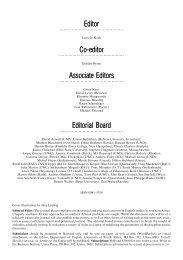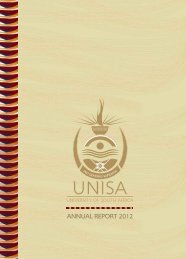pdf: 6.426kb - University of South Africa
pdf: 6.426kb - University of South Africa
pdf: 6.426kb - University of South Africa
Create successful ePaper yourself
Turn your PDF publications into a flip-book with our unique Google optimized e-Paper software.
News and Information<br />
The <strong>South</strong> American Summit:<br />
A new era for Brazilian foreign policy<br />
by Ze lia Roel<strong>of</strong>se-Campbell<br />
Head, Unisa Centre for Latin American Studies<br />
For the first time in history, all the presidents <strong>of</strong> <strong>South</strong><br />
America met at a summit, called by Brazil's President<br />
Fernando Henrique Cardoso. The summit took place<br />
on 31st August and 1st September in BrasõÂ lia.<br />
The 12 countries 1 represent a population <strong>of</strong> 337<br />
million people and total GDP <strong>of</strong> US$ 1,5 trillion and are<br />
currently grouped into two main free trade blocs, namely<br />
Mercosul and the Andean Community <strong>of</strong> Nations<br />
(CAN). Mercosul comprises Argentina, Brazil, Paraguay<br />
and Uruguay, with Bolivia and Chile as associate<br />
members. The countries <strong>of</strong> the Andean Community <strong>of</strong><br />
Nations are: Bolivia, Colombia, Ecuador, Peru and<br />
Venezuela. English-speaking Guyana and Dutch-speaking<br />
Suriname were also included at the summit, as they<br />
form an integral part <strong>of</strong> <strong>South</strong> America 2 .<br />
The summit was universally regarded as marking a<br />
new phase in Brazilian foreign policy. For example,<br />
The New York Times headlined an article on the<br />
summit `Brazil Begins to Take Role on the World<br />
Stage' (Rohter 2000), while Correio Braziliense<br />
described it as `an historic landmark' (um marco<br />
histoÂrico) (GarcõÂ a 2000).<br />
Writing before the summit, President Cardoso described<br />
it as a `reaffirmation <strong>of</strong> <strong>South</strong> America's<br />
identity as a region where democracy and peace<br />
advance the prospects for an increasingly energetic<br />
process <strong>of</strong> integration among countries that live<br />
together in the same neighbourhood' (Cardoso 2000).<br />
The timing <strong>of</strong> the summit was explained by the<br />
Brazilian Ambassador to the United States in an<br />
address at the National Press Club in Washington DC:<br />
We think that after NAFTA was signed in 1994, a<br />
new economic geography began to take shape in<br />
the hemisphere with very clear cut differentiations:<br />
NAFTA, North America, with three countries; then<br />
Central America with the Central American Common<br />
Market; CARICOM, with the countries <strong>of</strong> the<br />
Caribbean forming this political and economic<br />
entity; and <strong>South</strong> America, the fourth area. In<br />
<strong>South</strong> America we have two regional groupings,<br />
the Mercosur, from 1990, and the Andean Pact<br />
from 1969. This is, in economic terms, financial<br />
terms, from companies' point <strong>of</strong> view, what is really<br />
happening in the hemisphere ... <strong>South</strong> America as a<br />
unit, as a group <strong>of</strong> countries, is sort <strong>of</strong> left over, and<br />
now we decided to do something about that ... Our<br />
shared geography, history, values point out to a<br />
unit, an integrated part <strong>of</strong> the world ... This is<br />
beginning, as Brazil sees it, to create a new identity<br />
<strong>of</strong> the region with a common agenda, and with<br />
geo-economic concerns ± not geopolitical concerns<br />
± ... because the motivation <strong>of</strong> all this is<br />
mainly the economy, trade, finance, but not<br />
exclusively, because there are political considerations<br />
as well ... (Barbosa 2000). (See table 1.)<br />
The main topics <strong>of</strong> the agenda were: strengthening<br />
<strong>of</strong> democracy; expansion <strong>of</strong> trade; development <strong>of</strong><br />
integration infrastructure; combating illicit drugs and<br />
related crimes; information, science and technology.<br />
The particular objectives <strong>of</strong> Brazil were to strengthen<br />
the links among the countries <strong>of</strong> <strong>South</strong> America,<br />
improve the utilization <strong>of</strong> regional energy, communications,<br />
transport and trade resources, and strengthen<br />
regional integration by ensuring support for this at<br />
62 ISSN 0256±6060±Unisa Lat. Am. Rep. 16(2) 2000

















